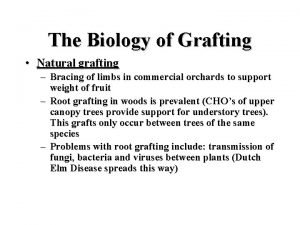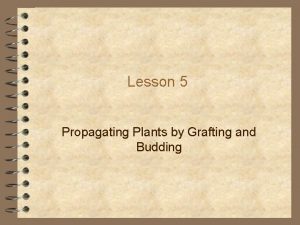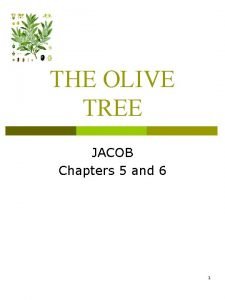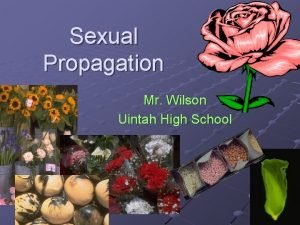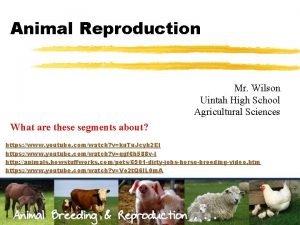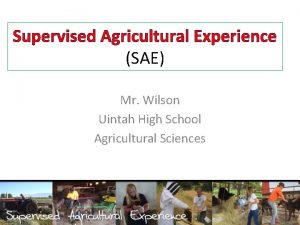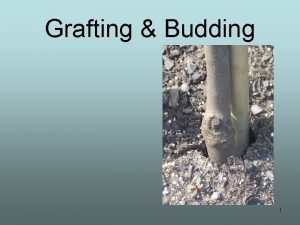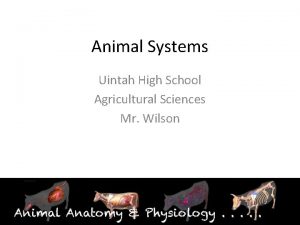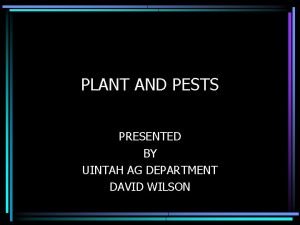Grafting Mr Wilson Uintah High School What is




























- Slides: 28

Grafting Mr. Wilson Uintah High School

What is grafting? Grafting is a process by which two different plants are united so that they grow as one. The scion is the newly installed shoot or top of the plant. The rootstock is the seedling or plant used as the bottom half of the plant. It becomes the root system of the newly grafted plant. Allows for unusual combinations Several varieties of apples can be grown on one tree Several colors of roses can be on one bush Graft Union Where the two parts meet

Grafting two different plants are united so they grow together as one Scion - top - vegetative part Stock - bottom - root part

History ancient technique practiced as early as 1, 000 BC employed widely by the Romans centuries later

Why is grafting used? Rapidly increases the number of desirable plants. Gives plants stronger, more disease-resistant roots. To topwork a large tree. To insert a different variety on part of the limbs of the tree. To propagate plants that may be difficult to bud. cause dwarfing top working - grafting many different varieties to the limbs of one tree

What are the requirements for successful grafting? Compatibility Scion wood The plants must be closely related to each other so the scion and stock are able to grow together. The scion wood should be one year old and of vigorous growth. Timing Grafting is usually done when the stock and scion are dormant and have no leaves.

What are the requirements for successful grafting? Matching of tissue The cambium layer of the two matched plant parts must come in close contact and be held tightly together. Waterproofing After the graft is made all cut surfaces must be covered with a waterproof material like grafting wax, plastic ties, or rubber ties. stock and scion should be dormant or have no leaves

What is budding? In budding a single bud is used instead of a scion like in grafting.

Why is budding used? More plants can be reproduced from the same amount of parent wood. Budding is accomplished more quickly. Budding can take place at different times than grafting can.

What are some rules to follow to keep newly propagated plants disease-free? Hoses are not to be put in direct contact with the ground. Keep greenhouse floor clean. Keep all benches clean of plant material and debris. After propagating plants, clean all equipment. Clean knives by washing off with water, and then dip in rubbing alcohol. Return equipment to proper storage place.

Methods Of Asexual Propagation (cont. . ) 4 - The goal of grafting is to connect or fit two tissues of living plant issue together in such as way that they will unite and subsequently behave as one plant.

Methods Of Asexual Propagation (cont. ) 5 - Budding is the place of a single detached bud upon the stock.

VEGETATIVE PROPAGATION Grafting and Budding Grafting and budding are fairly complex methods of propagation used for reproducing valuable fruit and ornamental cultivars in nurseries. Budding & grafting unite genetically different plants so they heal together & function as a single plant. An amateur who wishes to try should plan ahead and consult reference books for more in-depth information. • Budding transfers a bud of one plant to another plant that will function as the root system, whereas grafting attaches a small branch to another plant. – Most frequently combining two cultivars of a species into one plant that exhibits the best features of each.

VEGETATIVE PROPAGATION Grafting and Budding Grafting can also serve other purposes: Repair of girdled trees that would otherwise die. Creation of unusual plant forms such as tree roses or trees with weeping heads atop strong, straight trunks. Changeover of old orchard fruit trees to a new cultivar. Grafting & budding rely on activity of cambium cells. Must be done when the cells are dividing actively and will heal the grafted area quickly. To determine the correct stage for grafting, bark is examined for slippage.

VEGETATIVE PROPAGATION Grafting and Budding Rootstock diameter must be equal to or larger than that of the scion. Cambium of the stock & scion must be in contact, preferably over as great an area as possible. Scion wood is usually a pencil thickness or slightly larger. If contact isn’t made, the graft won’t heal & the scion dies. The stock and scion must fit tightly together, and the joint must be protected from drying. A tight graft union is achieved by wrapping the area with special rubber ties or waxed string. Drying is prevented by a coating of wax.

VEGETATIVE PROPAGATION Grafting and Budding Basic steps involved in a style called whip grafting. Stock & scion cut to equal size and ready for grafting. Figure 5 -27 a Steps in performing a whip graft. Courtesy CEV Multimedia, Ltd. , Lubbock, Tx.

VEGETATIVE PROPAGATION Grafting and Budding Basic steps involved in a style called whip grafting. Stock & scion joined and held together with a rubber strip. Figure 5 -27 b Steps in performing a whip graft. Courtesy CEV Multimedia, Ltd. , Lubbock, Tx.

VEGETATIVE PROPAGATION Grafting and Budding involves removing a patch of bark with a bud from a scion and laying it directly against the cambium of the stock. Less risky than grafting because the stock is damaged only slightly if the union doesn’t heal. As with grafting, the area of the union must be protected from drying with rubber ties. Figure 5 -28 Bud patches to be used in budding (upper) and a bud patch in place on a branch (lower). Photo courtesy of Dr. Robert F. Carlson.

VEGETATIVE PROPAGATION Tissue Culture Tissue culture, also called micropropagation, is the propagation of plants from nearly microscopic portions of parent plants. Importance of propagation from virus- free parent stock has come to be appreciated recently as the detrimental effects of unrecognized virus infection have become known. Figure 5 -29 Tissue-cultured strawberries. Photo courtesy of Barbara M. Reed, National Clonal Germplasm Repository, Corvallis, Ore.

VEGETATIVE PROPAGATION Tissue Culture The technique has two distinct advantages over traditional propagation: It enables mass production of a cultivar from an extremely limited amount of parent stock, in a relatively small area. It enables the propagator to eliminate disease-causing viruses from the parent material, unattainable through the use of pesticides. And to propagate numerous virus-free offspring that are healthy and vigorous.

VEGETATIVE PROPAGATION Tissue Culture Tissue culture is not an amateur activity, because it is nearly impossible to achieve the sterile conditions necessary. Tissue-cultured plants still in test tubes are sold in nurseries occasionally as novelty items. Particularly orchids, which were the main plants tissue cultured for many years. The test tube is left sealed and treated as a miniature terrarium. When the plant outgrows the tube it sometimes can be transplanted to a pot, though the process is not always successful.

GENETIC ENGINEERING Genetic engineering can harness the biological machinery of bacteria and viruses to… Manufacture otherwise hard-to-obtain plant products. Combat genetically caused diseases. Improve tolerance of plants to adverses. Attain other similar commendable goals. For plant improvement, it changes the genetic makeup of plants, without breeding or selection. Its main advantage is that it makes possible the transfer of genes between completely unrelated plants or bacteria. In rare cases, even from animals to plants.

COMMERCIAL APPLICATION OF GENETIC ENGINEERING In commercial horticultural production, research has centered mainly on vegetable and fruit crop genetic engineering. With a limited amount on flowers and other crops. Although genetically engineered crops are in widespread cultivation, most are not horticultural.

COMMERCIAL APPLICATION OF GENETIC ENGINEERING Generally, genetic engineering of horticultural crops has focused on Imparting disease and pest resistance. Imparting resistance to herbicides. Extending the length of product shelf life. Altering color. In flowers. Imparting cold-temperature resistance. In strawberries and eucalyptus trees.

COMMERCIAL APPLICATION OF GENETIC ENGINEERING One of the best known genetically engineered horticultural crops is the ‘Flavr Savr’ tomato. Tomatoes destined for fresh eating must be handharvested to prevent bruising. Engineered to retain a firm texture longer than normal. Unlike canning tomatoes that can be harvested mechanically—a less expensive process. Fresh tomatoes must also be transported quickly and with careful packaging. To ensure that they arrive at the supermarket in an attractive condition, appealing to the buyer.

COMMERCIAL APPLICATION OF GENETIC ENGINEERING The ‘Flavr Savr’ inhibits expression of the genetic material that causes fruit to soften when it ripens. The softening part of ripening is slowed, although the flavor continues to develop. This allows mechanical harvesting, increased transport time, and longer fresh shelf life in the supermarket.

COMMERCIAL APPLICATION OF GENETIC ENGINEERING A second genetically engineered crop receiving widespread attention is a Thompson Seedless grape variety engineered to be virus resistant. One of the most commonly cultivated table grapes. Also a component of blended wines.

COMMERCIAL APPLICATION OF GENETIC ENGINEERING Scientists hope that genetically engineered virus resistance will reduce the expense of chemicals, and their entry into the environment. Because it will no longer be necessary to spray to prevent the disease. At present, only papaya & squash have been engineered successfully for virus resistance and put into field production.
 South forsyth high school laura wilson
South forsyth high school laura wilson Bridge graft
Bridge graft Principles of grafting
Principles of grafting Patch budding
Patch budding Jacob leaf levy
Jacob leaf levy Crescenta valley high school graduation 2021
Crescenta valley high school graduation 2021 Assignment in spanish
Assignment in spanish High precision vs high recall
High precision vs high recall High precision vs high recall
High precision vs high recall Directive behavior and supportive behavior
Directive behavior and supportive behavior High expectations high support
High expectations high support Significant figures
Significant figures High directive and high supportive behavior
High directive and high supportive behavior Pengertian investasi
Pengertian investasi Www xxx school
Www xxx school Chemistry parody songs
Chemistry parody songs Nackawic high school powerschool
Nackawic high school powerschool Windermere high school principal
Windermere high school principal T-stem early college high school
T-stem early college high school Whrhs.org
Whrhs.org Powerschool login waukee
Powerschool login waukee Language in french
Language in french Tucson high magnet school
Tucson high magnet school Pope high school marching band
Pope high school marching band The glen high school moodle links
The glen high school moodle links Alvin high school jacketeers
Alvin high school jacketeers Steinmetz high school uniform
Steinmetz high school uniform St robert catholic high school ib program boundary
St robert catholic high school ib program boundary Ramstein high school
Ramstein high school

